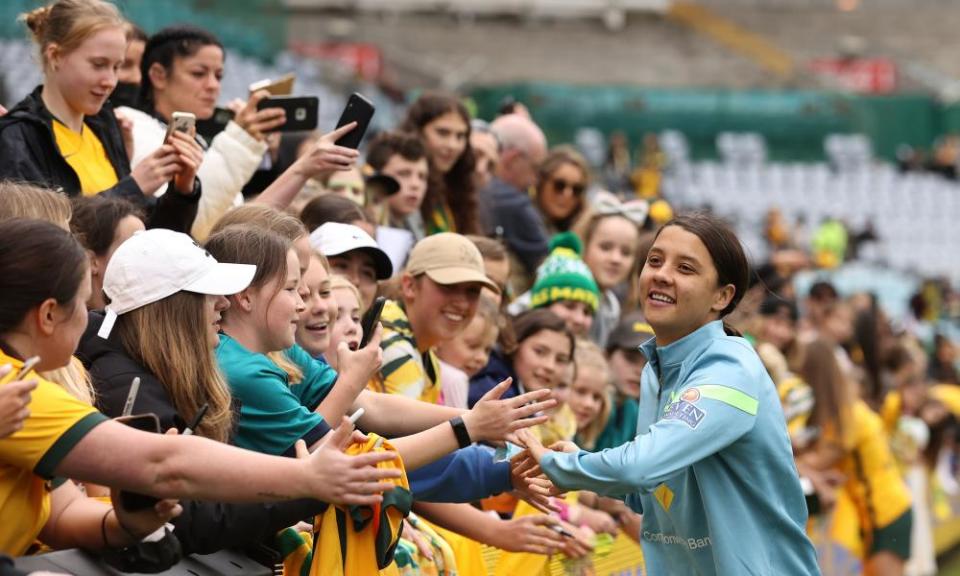Great expectations, no guarantees as USWNT expose Matildas frailties

A record crowd pointed to a bright future, but the same old problems remain for the Matildas
Almost as soon as it was locked in, Saturday afternoon’s meeting between Australia and the United States Women’s National Team (USWNT) was positioned as a celebration of the present and future of Australian women’s football. But in downing the Matildas 3-0 the United States provided another potent reminder to Australian football that, despite the great expectations it holds with a home World Cup on the horizon, the future is never guaranteed.
As 36,109 fans watched on - the highest ever crowd for a women’s football match in Australia - the United States proved quite happy to spoil their hosts’ party, proving to be simply the better team in the moments when it counted; taking advantage of some calamitous errors and naivety in approach to claim a clinical win behind goals from Ashley Hatch, Rose Lavelle and Lindsey Horan (who made good on her goal of “shutting up” a hostile home crowd).
It was a performance that was hardly dominant in nature. Australia enjoyed a 15-minute patch towards the end of the first half where they could have tipped the game in their favour by if only they were more clinical - but it didn’t need to be.
Related: Australia 0-3 USA: international women’s football friendly – as it happened
In the absence of first-choice centre-back pairing Alanna Kennedy and Clare Polkinghorne, 19-year-old Courtney Nevin and 17-year-old debutant Jessika Nash were tapped by Matildas coach Tony Gustavsson to start at the heart of his side’s defence; Nash the 13th debutant in 2021 Alas for the teen pair, this bow as a defensive duo turned less than auspicious within seconds - rendered naught but helpless observers as Hatch stole in behind to collect a pass from Lynn Williams and fire beyond keeper Teagan Micah. Arriving just 24 seconds after referee Hyeon Jeong Oh blew her whistle, it was the second quickest goal the Matildas have ever conceded in a competitive fixture – only Canada’s 20-second effort at Rio 2016 was delivered in a more rapid fashion.

The issue of centre-back has proven a constant and vexatious one for the Matildas; a problem area whose solution, despite best efforts, remains frustratingly ambiguous. Since commencing his tenure at the start of 2021, Gustavsson has chopped and changed both personnel and formation in an attempt to address a backline that has now conceded 36 goals in 15 games. Yet for green-and-gold aficionados, the issues that were on show in the first friendlies the Swede was in charge of at the beginning of the year - which included a 5-2 loss to Germany and a 5-0 defeat to the Netherlands - continue to challenge at its conclusion. Disquietingly, they have been present against both the technical proficiency of European opposition and the pace and power of the United States.
Somewhat obscured by the foibles in the backline, however, has been a midfield that, outside of phases of transition, has struggled to break down set defences and control the tempo of games. Not only does this carry obvious ramifications for the side in attack, placing an increased reliance on forwards to produce individual, game-breaking moments, it also adds pressure to the defence behind it by ceding control of the pace of games to their foes and by virtue, the areas on the park that the ball is lost.
An opportunity to show some form of improvement, and source a bit of redemption, will arrive on Tuesday when these same two sides meet in Newcastle, before the Matildas shift back into what Gustavsson has come to call “performance mode” when they begin their Asian Cup campaign in January.
The pressure of World Cup qualification removed by virtue of their hosting, the next year and a half can then be wholly devoted to improving the Matildas trajectory.
Indeed, within fiction, there are two overarching tropes that generally govern a protagonist’s relationship with the future, perhaps best surmised as the ‘Back to the Future’ paradigm or the ‘Terminator’ approach. In the latter interpretation, the events of the future are an unflinching and inescapable reality: no matter how many steps one takes, no matter how many things one changes, Judgement Day arrives all the same. In the former approach though, events yet to pass are not yet set in stone but, instead, can be shaped and moulded by those armed with the knowledge of what needs to be done.
Having styled the game as a dress rehearsal for the World Cup final at the same venue in 631 days time, Gustavsson could now be said to have been given his own copy of ‘Grays Sports Almanac’; a glimpse of what lies ahead for his side should they stay on the path that they are on. Now he can work to change it - lest Judgment Day for this group arrive.

 Yahoo Sport
Yahoo Sport 





































